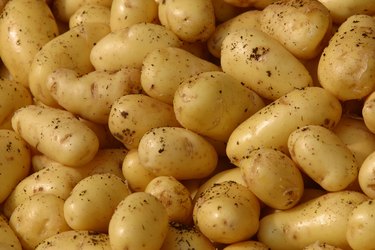
Potatoes pack an abundance of nutritional value, including a high dose of macronutrients, vitamins and minerals. One of the potato's greatest nutritional offerings is its carbohydrate content. Potatoes contain both simple and complex carbohydrates, as well as a substantial amount of dietary fiber. Most of the carbohydrates in potatoes are complex carbohydrates, called starch. Potatoes also contain simple sugars, with glucose being the most prevalent. Because of their rapid effect on blood sugar levels, potatoes have caused some debate among nutrition experts.
Carbohydrate Basics
Video of the Day
All carbohydrates are composed of one or more sugar molecules. Complex carbohydrates, or starches, are composed of more than two sugar molecules, while simple carbohydrates, or sugars, are composed of two or less. When the body consumes carbohydrates, they are converted to natural sugar, glucose, where they are used for energy. Because of their more complex chemical structure, complex carbohydrates take longer to be absorbed and have a more gradual effect on blood glucose levels, while simple sugars are digested quickly and provide quick energy.
Video of the Day
Carbohydrates in Potatoes
One large potato with both the flesh and the skin, weighing 369 grams, contains 64.46 grams of carbohydrates, according to the USDA Nutrient Database. An adult who consumes a 2,000-calorie diet generally needs about 225 to 325 grams of carbohydrates each day. Just one potato, therefore, contributes nearly 30 percent of the typical adult's minimum daily carbohydrate needs.
Potato Starch and Glucose
Of the 64.46 grams of carbohydrates in a potato, 56.97 grams exist in the form of starch. Starch is a complex carbohydrate that consists of multiple glucose molecules attached together. Because the body converts the carbohydrates it consumes into glucose, potatoes are easily digested and have a high glycemic index, or the rate at which carbohydrates cause a rise in blood glucose levels after you eat something.
Glycemic Index of Potatoes
A glycemic index of 70 or above is considered high, and potatoes have glycemic indexes ranging from about 58 to 111, depending on the variety and how they are cooked. For example, a russet potato has a glycemic index of 76. Foods that have a high glycemic index often face scrutiny in the weight-loss community because of their undulating effects on blood glucose levels. These sharp spikes in blood sugar levels are believed by some, including the Glycemic Index website of the University of Sydney, to contribute to weight gain and diabetes.
Glycemic Load of Potatoes
The glycemic index simply measures how quickly a carbohydrate is converted to sugar after consumption, but it does not take into account the food's serving size or nutritional value. For example, watermelon has a higher glycemic index than soda, although the former is clearly better for you than the latter. The glycemic load was created to provide a better reflection of a particular food's effect on blood sugar and nutritional value. While a russet potato has a high glycemic index, it has a much lower glycemic load, with a measure of 23.
- Washington State Potato Commission: Washington Potatoes Are Nutritious
- USDA National Nutrient Database: Potato, Flesh and Skin, Raw
- Cleveland Clinic: Heart and Vascular Health and Prevention: Bringing the Science to Your Dinner Table
- The University of Sydney: Glycemic Index: GI Database: Potato
- Linus Pauling Institute, Oregon State University: Glycemic Index and Glycemic Load
- KidsHealth: Learning About Carbohydrates
Is this an emergency? If you are experiencing serious medical symptoms, please see the National Library of Medicine’s list of signs you need emergency medical attention or call 911.